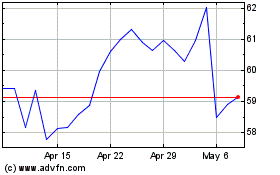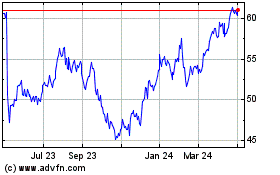By Jaewon Kang and Annie Gasparro
U.S. grocers are adjusting their operations to try to keep up
with customers who are emptying their shelves amid angst over the
new coronavirus, even as their own employees face heightened risk
of infection.
Across the country, lines to get into stores snaked around
corners, checkout times stretched as long as an hour and whole
aisles were rendered bare this week as companies told more workers
to stay home and schools began to cancel classes.
President Trump on Sunday held a conference call with more than
two dozen grocery and supply chain executives, including those from
Walmart Inc., Target Corp., Costco Wholesale Corp., Sysco Corp. and
Tyson Foods Inc.
Kroger Co. Chief Executive Rodney McMullen wrote in a memo to
employees on Sunday that a worker in Colorado and another in
Washington tested positive for Covid-19, the respiratory disease
caused by the virus. He said the stores will remain open and that
the nation's biggest supermarket chain would give paid time off to
workers diagnosed with Covid-19 and those placed under mandatory
quarantine.
"Our stores, facilities, plants and offices are busier than ever
before, " Mr. McMullen wrote.
Kroger and Trader Joe's said they were shortening store hours to
give workers more time to clean and restock.
Publix Super Markets Inc., which operates more than 1,100
stores, on Saturday said it would shorten store and pharmacy hours
to close at 8 p.m. Walmart Inc. said its U.S. stores would close
overnight to clean and disinfect surfaces. Wegmans Food Markets
Inc. said it would shorten hours, trim options at its hot-food bars
and set purchase limits for foods including eggs, frozen
vegetables, boxed cereal and rice.
Some retailers added security in their stores. Target said it
has increased off-duty police presence in some stores and Costco
said it is adding additional security at a handful of locations.
The Washington State Department of Health urged consumers not to
overstock.
Food companies had been preparing for greater demand, but the
surge was higher and faster than expected, executives said.
"We don't know how to anticipate for that," said Susan Morris,
chief operating officer at Albertsons Cos., the nation's
second-largest grocer.
She said the company spent the past two weeks adding extra stock
at its more than 2,200 stores. But "you get to a point in time
where products are simply not available." Albertsons said it is
also carrying less variety of goods to speed up the restocking
process.
Some of the supermarkets run by Koninklijke Ahold Delhaize NV,
owner of the Stop & Shop and Food Lion chains, were running low
on bottled water, cheese and other items this week.
JJ Fleeman, president of Peapod, the online delivery business
for Ahold, said it expected demand for some items to be several
times higher than usual, but the surge this week was several times
higher than that.
"We're literally making adjustments in the moment," Mr. Fleeman
said.
Peapod said it is adding drivers and warehouse workers and
installing more computer servers to handle orders faster. Its
website briefly crashed in some parts of the country on Friday
while those upgrades were taking place.
Executives say they are confident near term they can meet
demand, especially now that many households have "pantry loaded."
Longer term they are trying to make adjustments in case of deeper
threats to the supply chain.
In the U.K., where online deliveries make up about 7.7% of the
grocery market according to research firm Kantar, more than double
the share in the U.S., retailers have also warned their services
could be stretched as the pandemic advances.
Early Sunday, in a joint letter published in British newspapers,
the country's largest supermarkets asked shoppers to "be
considerate in the way they shop" and stop buying more than
needed.
"There is enough for everyone if we all work together," said the
letter. It sought to reassure shoppers that supermarkets were doing
everything they could to restock shelves quickly and that online
delivery and click-and-collect services were "running at full
capacity."
U.S. retailers have experience preparing for surges in demand
ahead of natural disasters such as hurricanes and blizzards. This
pandemic is unique because it created a similar emergency across
the entire country with no clear end, said industry executives
including John Ross, CEO of IGA Inc., an association of about 600
U.S. independent grocers.
"The difference here is scaling up contingency plans for a
national emergency," he said.
Mark Hogan, a 41-year-old architect in San Francisco, started
buying extra snacks and other food two weeks ago. He said the pasta
and canned vegetables at his local Whole Foods had run out when he
went two days ago. The line at a nearby Trader Joe's on Friday was
three-blocks long, he said.
"It seems like at least in San Francisco, the reality completely
set in today," he said on Friday.
Warehouse workers and drivers are starting to feel the strain.
Steven Spinner, chief executive of distributor United Natural Foods
Inc., said during an earnings call this week that it has been
challenging to meet the rise in demand over the past two weeks.
Distributors and retailers are "spending 28 hours a day" to keep
the stocks full, he said.
The delivery operations that other food sellers built out in
recent years to compete with Amazon.com Inc. have also been
strained because of the sudden demand in recent days.
Amazon Prime Now, the online ordering service that delivers
within a few hours, said there were no delivery slots available
this weekend in some cities such as New York.
Target on Friday paused next-day delivery of online orders
around the country amid high demand from shoppers stocking up on
household items. Grocery delivery company Fresh Direct LLC on
Thursday warned its customers of delays and said its employees will
bring items only to the door.
Supermarket operators are now trying to speed up orders from
suppliers and are hiring more workers in stores to refill empty
shelves. Albertsons' Seattle division said on Thursday that it is
hiring drivers and in-store workers immediately.
Mike Fogarty, owner of a two-store chain called Choice Market in
Colorado, said his team has been working around the clock to try to
keep shelves full. They ran out of rubbing alcohol and some
cleaning supplies this week and he expects some dried foods to sell
out this weekend.
After his supplier told him it couldn't supply toilet paper for
his chain until April 1, he found a manufacturer that makes larger
rolls for stadiums and concert venues. He worries he won't have as
much luck replacing some other goods such as produce if suppliers
choose to first serve bigger retailers asking for more product.
"It's fundamentally a whole new era," he said.
The manufacturers of toilet paper and other items flying off
store shelves say they are ramping up production to meet higher
demand for their household essentials and long-lasting foods.
John Church, chief supply chain officer at General Mills Inc.,
said his team is making last-minute changes to where it sends
inventory to meet demand. "We have plants running at near
capacity," he said.
Conagra Brands Inc. is devoting more of its factory lines to
top-selling items. Campbell Soup Co. Chief Executive Mark Clouse
said the company is lining up multiple suppliers for important
ingredients, in case factories around the world close.
Michael Kirban, CEO of Vita Coco, said he is ramping up
production of his coconut water in Brazil to meet high demand in
the U.S. He said weekly sales have spiked 200% at Walmart.com and
60% at Amazon.com.
"No one can prepare for that. Not even Amazon," Mr. Kirban
said.
--Alex Leary contributed to this article.
Write to Jaewon Kang at jaewon.kang@wsj.com and Annie Gasparro
at annie.gasparro@wsj.com
(END) Dow Jones Newswires
March 15, 2020 16:02 ET (20:02 GMT)
Copyright (c) 2020 Dow Jones & Company, Inc.
Tyson Foods (NYSE:TSN)
Historical Stock Chart
From Mar 2024 to Apr 2024

Tyson Foods (NYSE:TSN)
Historical Stock Chart
From Apr 2023 to Apr 2024
